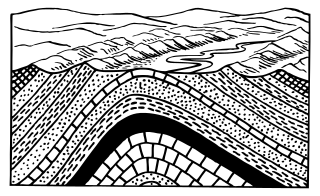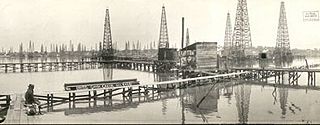
The history of the petroleum industry in the United States goes back to the early 19th century, although the indigenous peoples, like many ancient societies, have used petroleum seeps since prehistoric times; where found, these seeps signaled the growth of the industry from the earliest discoveries to the more recent.

Assumption Parish is a parish located in the U.S. state of Louisiana. As of the 2020 census, the population was 21,039. Its parish seat is Napoleonville. Assumption Parish was established in 1807, as one of the original parishes of the Territory of Orleans.
Pierre Part is a census-designated place (CDP) in Assumption Parish, Louisiana, United States. The population was 3,169 at the 2010 census, making it the most populous community in Assumption Parish. With 39.3 percent of the population speaking French at home, Pierre Part is the most French town in the United States outside of Maine. Pierre Part is known locally for its prominent French influence and ancestry, which have become significant aspects of its contemporary local culture. Situated near Lake Verret, Pierre Part is a popular local destination for water sports and fishing during the summer.

The Strategic Petroleum Reserve (SPR) is an emergency stockpile of petroleum maintained by the United States Department of Energy (DOE). It is the largest publicly known emergency supply in the world; its underground tanks in Louisiana and Texas have capacity for 714 million barrels (113,500,000 m3). The United States started the petroleum reserve in 1975 to mitigate future supply disruptions as part of the international Agreement on an International Energy Program, after oil supplies were interrupted during the 1973–1974 oil embargo.

A salt dome is a type of structural dome formed when salt intrudes into overlying rocks in a process known as diapirism. Salt domes can have unique surface and subsurface structures, and they can be discovered using techniques such as seismic reflection. They are important in petroleum geology as they can function as petroleum traps.

Occidental Petroleum Corporation is an American company engaged in hydrocarbon exploration in the United States, and the Middle East as well as petrochemical manufacturing in the United States, Canada, and Chile. It is organized in Delaware and headquartered in Houston. The company ranked 183rd on the 2021 Fortune 500 based on its 2020 revenues and 670th on the 2021 Forbes Global 2000.
Lake Peigneur is a brackish lake in the U.S. state of Louisiana, 1.2 miles north of Delcambre and 9.1 mi (14.6 km) west of New Iberia, near the northernmost tip of Vermilion Bay. With a maximum depth of 200 feet, it is the deepest lake in Louisiana. Its name comes from the French word "peigneur", meaning "one who combs."

In structural geology, an anticline is a type of fold that is an arch-like shape and has its oldest beds at its core, whereas a syncline is the inverse of an anticline. A typical anticline is convex up in which the hinge or crest is the location where the curvature is greatest, and the limbs are the sides of the fold that dip away from the hinge. Anticlines can be recognized and differentiated from antiforms by a sequence of rock layers that become progressively older toward the center of the fold. Therefore, if age relationships between various rock strata are unknown, the term antiform should be used.

The Louisiana Offshore Oil Port (LOOP) is a deepwater port in the Gulf of Mexico 29 kilometers off the coast of Louisiana near the town of Port Fourchon. LOOP provides tanker offloading and temporary storage services for crude oil transported on some of the largest tankers in the world. Most tankers offloading at LOOP are too large for U.S. inland ports. LOOP handles 13 percent of the nation's foreign oil, about 1.2 million barrels (190,000 m3) a day, and connects by pipeline to 50 percent of the U.S. refining capability.

Vulcan Materials Company is an American company based in Birmingham, Alabama. It is principally engaged in the production, distribution and sale of construction materials. Vulcan is the largest producer of construction materials, primarily gravel, crushed stone, and sand, and employs approximately 12,000 people at over 400 facilities. Vulcan serves 22 states, the District of Columbia, Mexico, Canada, Bahamas and the U.S. Virgin Islands. Vulcan's innovative Crescent Market project led to construction of a large quarry and deep water seaport on the Yucatán Peninsula of Mexico, just south of Cancun. This quarry supplies Tampa, New Orleans, Houston, and Brownsville, Texas, as well as other Gulf coast seaports, with crushed limestone via large 62,000-ton self-discharging ships.

A petroleum reservoir or oil and gas reservoir is a subsurface accumulation of hydrocarbons contained in porous or fractured rock formations. Such reservoirs form when kerogen is created in surrounding rock by the presence of high heat and pressure in the Earth's crust.

Houston, the most populous city in the Southern United States, is located along the upper Texas Gulf Coast, approximately 50 miles (80 km) northwest of the Gulf of Mexico at Galveston. The city, which is the ninth-largest in the United States by area, covers 601.7 square miles (1,558 km2), of which 579.4 square miles (1,501 km2), or 96.3%, is land and 22.3 square miles (58 km2), or 3.7%, is water.

The Louann Salt is a widespread evaporite formation that formed in the Gulf of Mexico during the Callovian in the mid Jurassic. The Louann formed in a rift as the South American and North American Plates separated, from an embayment of the Pacific Ocean. The Louann underlies much of the northern Gulf Coast from Texas to the Florida panhandle and extends beneath large areas of the Gulf Coastal Plain of Mississippi, Louisiana and Texas.

The Goose Creek Oil Field is a large oil field in Baytown, Texas, on Galveston Bay. Discovered in 1903, and reaching maximum production in 1918 after a series of spectacular gushers, it was one of the fields that contributed to the Texas Oil Boom of the early 20th century. The field was also the location of the first offshore wells in Texas, and the second group of offshore wells in the United States. Consequences of the development of the Goose Creek field included an economic boom and associated influx of workers, the founding and fast growth of Baytown, and the building of the adjacent Baytown Refinery, which is now the 2nd largest oil refinery in the United States with a capacity of 584,000 barrels per day. The field remains active, having produced over 150 million barrels (24,000,000 m3) of oil in its 100-year history.

Scott Anthony Angelle is an American politician who is the former director of the Bureau of Safety and Environmental Enforcement in Washington, D.C. From 2013 to 2017, he was the District 2 member of the Louisiana Public Service Commission, an elected five-person utility regulatory body.
Bayou Corne is an unincorporated community and census-designated place (CDP) in Assumption Parish, Louisiana, United States, along the bayou of the same name. It is in the northwestern part of the parish along Louisiana Highway 70, 7 miles (11 km) west of Paincourtville and 6 miles (10 km) northeast of Pierre Part. The Bayou Corne sinkhole is less than one mile to the southeast.















